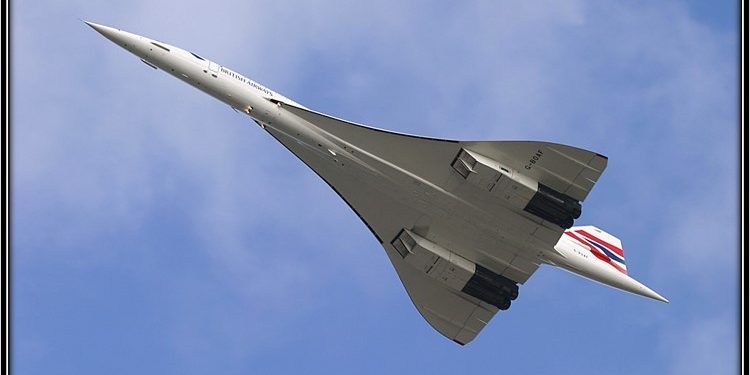Paying for the Luxury of Supersonic Flight
Contributor: Barry Fetzer
Sources: History.com
Happy New Year!. I hope each of you reading this will enjoy a happy and healthy 2024. Talk about flying, especially time flying? Where did 2023 get up and go off to so fast? As I sit here writing this and shaking my head in disbelief, it seems as if, at least to me, that 2023 came and went supersonically!
And speaking of time flying supersonically, in this aviation history vignette we’ll cover commercially viable supersonic passenger flight…a concept still in the works and not yet achieved, although not for want of trying. But the history of aviation, if it’s nothing else, is about persistence…about “keeping on keeping on”. As Zagar and Evens sang in their 1969 hit song, In the Year 2525, “In the Year 2525, if man is still alive, if woman can survive, they may find”…in fact, they probably will find, that flying supersonically to London from New York in less than three hours will be the standard, despite the 20th and 21st Century failures at commercial viability.
On this day in aviation history in 1968, the Soviet Union’s TU-144 supersonic airliner made its first flight, according to History.com, “several months ahead of the Anglo-French Concorde. The TU-144 so closely resembled the Concorde that the Western press dubbed it the ‘Konkordski.’”
“In 1962, 15 years after U.S. pilot Chuck Yeager first broke the sound barrier, Britain and France signed a treaty to develop the world’s first supersonic passenger airline. The next year, President John F. Kennedy proposed a similar U.S. project. Meanwhile, in the USSR, Soviet leader Nikita Khrushchev ordered his top aviation engineers to beat the West to the achievement.
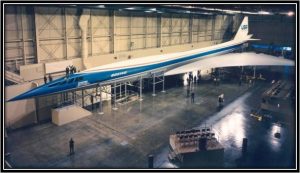
The Prototype mockup of the Boeing SST. Photo courtesy of Boeing.
According to Simpleflying.com, “The United States had ambitions to develop its own supersonic commercial jet, the Boeing 2707, as a competitor to Concorde and the Tupolev Tu-144. The Boeing 2707 received significant orders from airlines and was planned to be larger than Concorde, but the project was ultimately canceled due to economic issues, rising fuel costs, and environmental concerns.”
“There were immense technical challenges in building a supersonic airliner. Engines would need to be twice as powerful as those built for normal jets, and the aircraft’s frame would have to withstand immense pressure from shock waves and endure high temperatures caused by air friction. In the United States, Boeing tackled the supersonic project but soon ran into trouble with its swing-wing design. In England and France, however, early results were much more promising, and Khrushchev ordered Soviet intelligence to find out as much as possible about the Anglo-French prototypes.
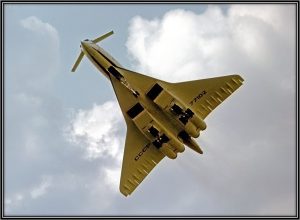
CCCP-77102, the Tu-144S involved in a 1973 Paris Air Show accident, seen inflight the day before the accident. Photo courtesy of Creative Commons. https://en.wikipedia.org/wiki/en:Creative_Commons
“In 1965, the French arrested Sergei Pavlov, head of the Paris office of the Soviet airliner Aeroflot, for illegally obtaining classified information about France’s supersonic project. Another high-level Soviet spy remained unknown, however, and continued to feed the Soviets information about the Concorde until the spy was identified and arrested in 1967. On December 31, 1968, just three months before the first scheduled flight of the Concorde prototype, the fruits of Soviet industrial espionage were revealed when the Soviet’s TU-144 became the world’s first supersonic airliner to fly.
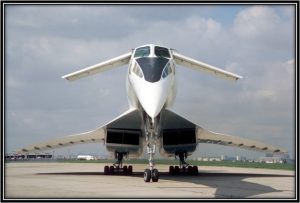
View of the front of the Tu-144, with the distinctive retractable “moustache” canards deployed and drooped nose.
Photo by Christian Volpati – http://www.airlinefan.com/airline-photos/large/1800968/Aeroflot/Tupolev/Tu-144/CCCP-77110/, GFDL 1.2, https://commons.wikimedia.org/w/index.php?curid=17114606
“In 1969, the Concorde began its test flights. Two years later, the United States abandoned its supersonic program, citing budget and environmental concerns. It was now up to Western Europe to make supersonic airline service viable before the Soviets. Tests continued, and in 1973 the TU-144 came to the West to appear alongside the Concorde at the Paris Air Show at Le Bourget airport. On June 3, in front of 200,000 spectators, the Concorde flew a flawless demonstration. Then it was the TU-144’s turn. The aircraft made a successful 360-degree turn and then began a steep ascent. Abruptly, it leveled off and began a sharp descent. Some 1,500 feet above the ground, it broke up from overstress and came crashing into the ground, killing all six Soviet crew members and eight French civilians.
“Soviet and French investigators ruled that pilot error was the cause of the accident. However, in recent years, several of the Soviet investigators have disclosed that a French Mirage intelligence aircraft was photographing the TU-144 from above during the flight. A French investigator confirmed that the Soviet pilot was not told that the Mirage was there, a breach of air regulations. After beginning his ascent, the pilot may have abruptly leveled off the TU-144 for fear of crashing into this aircraft. In the sudden evasive maneuver, the thrust probably failed, and the pilot then tried to restart the engines by entering a dive. He was too close to the ground, however, and tried to pull up too soon, thus overstressing the aircraft.
“In exchange for Soviet cooperation in the cover-up, the French investigators agreed not to criticize the TU-144’s design or engineering. Nevertheless, further problems with the TU-144, which was designed hastily in its bid to beat the Concorde into the air, delayed the beginning of Soviet commercial service. Concorde passenger service began with much fanfare in January 1976. Western Europe had won its supersonic race with the Soviets, who eventually allowed just 100 domestic flights with the TU-144 before discontinuing the airliner.
“The Concorde was not a great commercial success, however, and people complained bitterly about the noise pollution caused by its sonic booms and loud engines. Most airlines declined to purchase the aircraft, and just 16 Concordes were built for British Airways and Air France. Service was eventually limited between London and New York and Paris and New York, and luxury travelers appreciated the less than four-hour journey across the Atlantic.
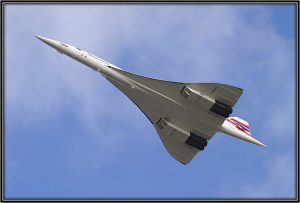
The final Concorde Flight. Photo courtesy of Flickr.com.
“On July 25, 2000, an Air France Concorde crashed 60 seconds after taking off from Paris enroute to New York. All 109 people aboard and four on the ground were killed. The accident was caused by a burst tire that ruptured a fuel tank, creating a fire that led to engine failure. The fatal accident–the first in the Concorde’s history–signaled the decline of the aircraft. The last Concorde flight was on October 24, 2003.”

